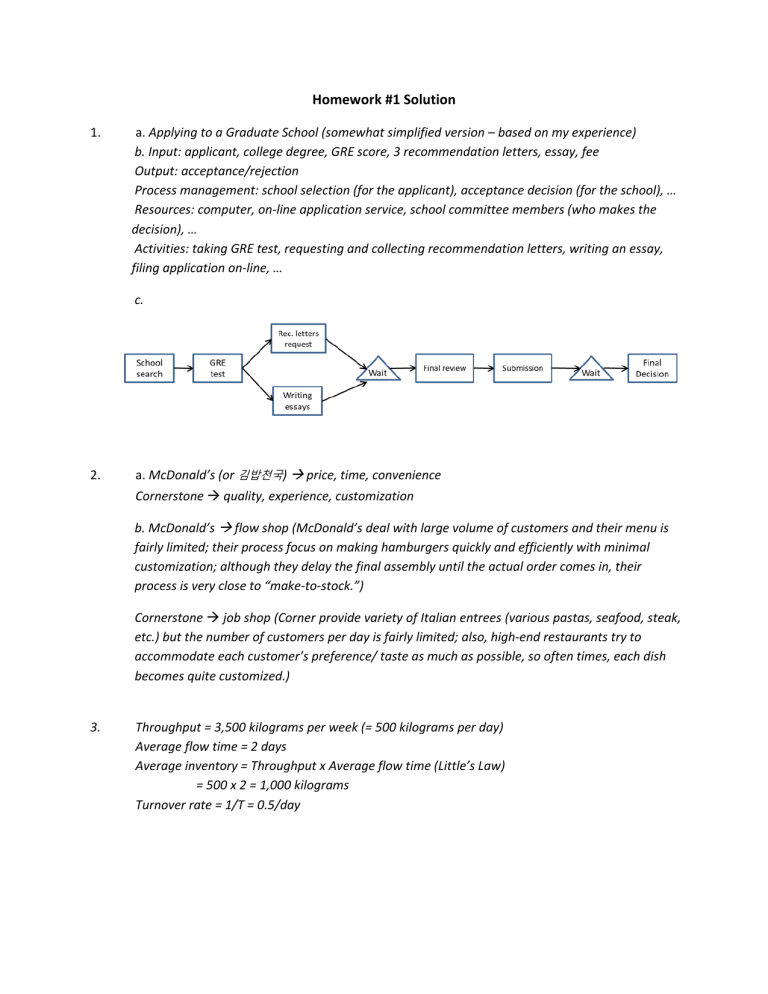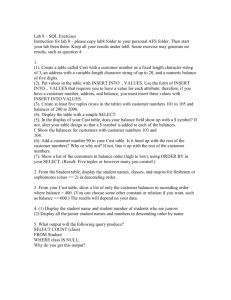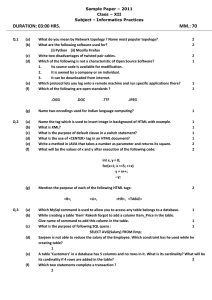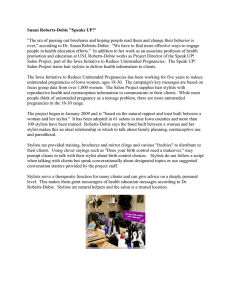
Homework #1 Solution 1. a. Applying to a Graduate School (somewhat simplified version – based on my experience) b. Input: applicant, college degree, GRE score, 3 recommendation letters, essay, fee Output: acceptance/rejection Process management: school selection (for the applicant), acceptance decision (for the school), … Resources: computer, on-line application service, school committee members (who makes the decision), … Activities: taking GRE test, requesting and collecting recommendation letters, writing an essay, filing application on-line, … c. 2. a. McDonald’s (or 김밥천국) price, time, convenience Cornerstone quality, experience, customization b. McDonald’s flow shop (McDonald’s deal with large volume of customers and their menu is fairly limited; their process focus on making hamburgers quickly and efficiently with minimal customization; although they delay the final assembly until the actual order comes in, their process is very close to “make-to-stock.”) Cornerstone job shop (Corner provide variety of Italian entrees (various pastas, seafood, steak, etc.) but the number of customers per day is fairly limited; also, high-end restaurants try to accommodate each customer’s preference/ taste as much as possible, so often times, each dish becomes quite customized.) 3. Throughput = 3,500 kilograms per week (= 500 kilograms per day) Average flow time = 2 days Average inventory = Throughput x Average flow time (Little’s Law) = 500 x 2 = 1,000 kilograms Turnover rate = 1/T = 0.5/day 4. a. First draw the flowchart with all the data given: There are two flow units: potential admits (flow rate = 55*10% = 5.5/hr) and simple prescription (flow rate = 55*90% = 49.5/hr). Using Little's Law at each activity, we find out the unknowns: - Buffer 1: R = 55/hr, I = 7, so that waiting time in buffer 1 = 7/55 hr = 0.127 hours = 7.6 minutes. Registration: T = 2 min = 2/60 hr, R = 55 / hr, so the inventory is I = 55*2/60 = 1.83 patients. Buffer 2: R = 55/hr, I = 34, so the waiting time is T = 34/55 hr = 0.62 hours = 37.1 minutes. Doctor time: (i) potential admits T1 = 30 minutes; (ii) simple prescription: T2 = 5 minutes. b. We now calculate the flow time of each flow unit: (i) For a potential admit, average flow time (buffer 1 + registration + buffer 2 + doctor) = 7.6 + 2 + 37.1 + 30 = 76.7 minutes. (ii) For a person ending up with a prescription, average flow time (buffer 1 + registration + buffer 2 + doctor) = 7.6 + 2 + 37.1 + 5 = 51.7 minutes. Therefore, the average flow time is: 10% of total flow units spend 76.7 minutes while 90% spend 51.7 minutes. Thus, T = 10%*76.7 + 90%*51.7 = 54.2 minutes. c. Calculate inventory of each type of flow unit: (i) Potential admits: R = 5.5 patients/hr, T = 30 min = 0.5 hr, thus, I = 5.5/hr*0.5 hr = 2.75 patients (ii) Simple prescription: R = 49.5 patients/hr, T = 5 min = (5/60) hr, thus I = 49.5*(5/60) = 4.125 patients Thus, total inventory at the doctor is 2.75 + 4.125 = 6.875 patients. d. The total inventory in ER = inventory in buffer 1 + inventory in registration + inventory in buffer 2 + inventory with doctors = 7 + 1.83 + 34 + 6.875 = 49.705 patients. 5. a. Current process at Fast Service Hair Salon Reception 3 minutes Lulu Shampooing 10 minutes Stylists Styling 15 minutes Stylists Billing 5 minutes Stylists b. The unit load from the three hair stylists is 10+ 15 +5 = 30 minutes per customer. Checking in (Lulu) takes 3 minutes. Thus, the capacity of the stylists is 3 * 60 /30 = 6 customers per hour, and of receptionist is 1* 60/3 = 20 customers per hour. The bottleneck are the stylists and thus the capacity of the current process is 6 customers per hour. Resource capacity Process Resource capacity utilization Unit capa. Unit # total Stylists 30min/cust. 2 cust./hr 3 6 cust./hr 100% 6 cust./hr 20 20 Receptionist 3min/cust. 1 30% cust./hr cust./hr c. If Lulu does the billing, the unit load of the stylists is reduced to 25 minutes per customer, and their capacity increases to 3* 60/ 25 = 7.2 customers per hour. On the other hand, receptionist’s unit load increases to 3+5 = 8 minutes per hour, and her capacity decreases to 60/8=7.5 customers per hour. The bottlenecks are still stylists, but the capacity will increase to 7.2 customers per hour. Resource capacity Process Resource resource Unit load capacity utilization Unit capa. Unit # total 2.4 7.2 Stylists 25min/cust. 3 100% cust./hr cust./hr 7.2 cust./hr 7.5 7.5 Receptionist 8min/cust. 1 96% cust./hr cust./hr resource 6. Unit load a. Since Rizzo is utilized less than 100%, he cannot be the BN. Between Lester and Maddon, one can find the BN through the table below. resource Unit load Resource capacity Unit capa. Unit # total 1.5/min 1 1.5 2/min 1 2 Process capacity Lester 40sec 1.5/min Maddon 30sec Rizzo The bottleneck is Lester. Then, one can show that Rizzo’s unit load is 30 sec. b. TFT will be 15+25+30 = 70sec. Resource utilization 100% 75% 75%


